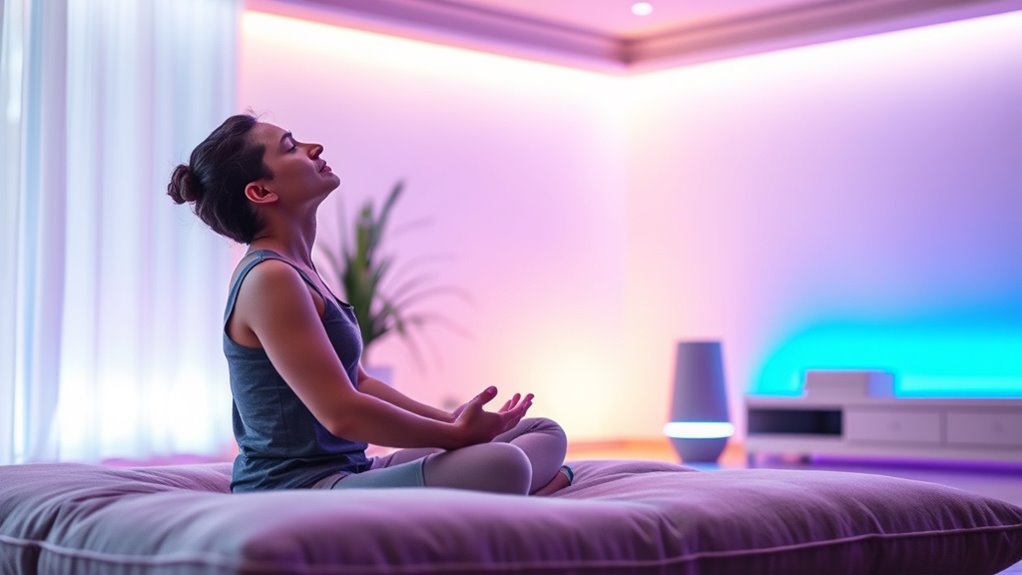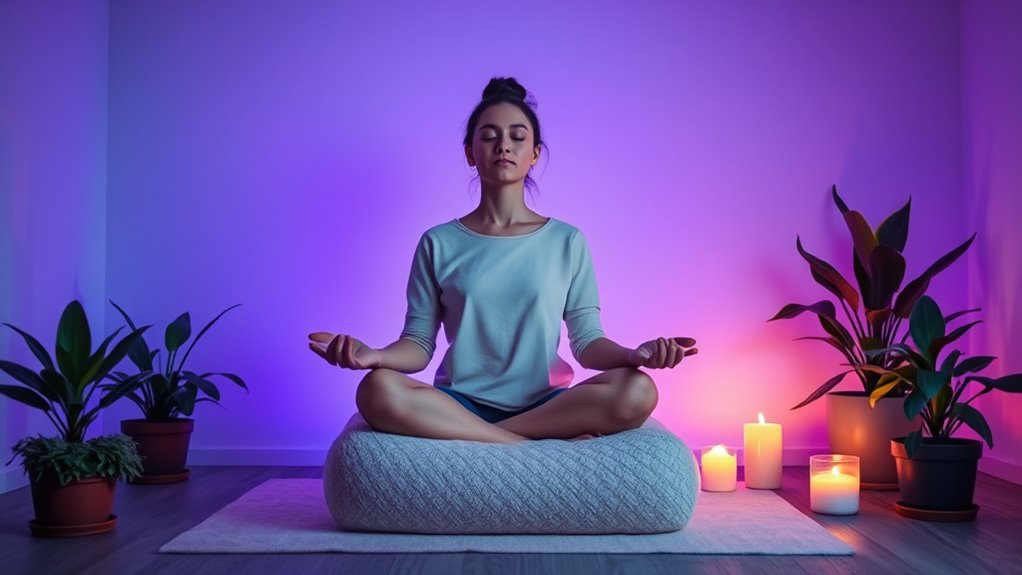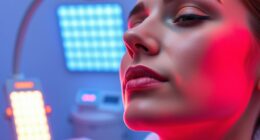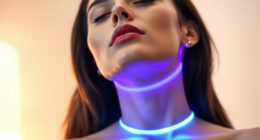To reduce stress with LED lighting, use warm, soft settings in your space, especially before bedtime, to promote relaxation and improve sleep quality. Adjust brightness and color temperature to create calming environments that help your body wind down and lower tension. Incorporate routines like dimming lights during stressful moments or pairing gentle lighting with relaxation exercises. Keep exploring for more simple ways to harness LED lighting to support your mental well-being and overall calmness.
Key Takeaways
- Use warm, soft LED lighting in the evening to promote relaxation and support melatonin production for better sleep.
- Dim or adjust LED brightness and color temperature during stressful moments to create a calming environment.
- Incorporate adjustable LED lights with routines like gentle breathing or stretching to enhance relaxation.
- Pair lighting changes with mindfulness practices for a more effective stress relief session.
- Create a consistent lighting routine that signals your body to unwind and develop healthy stress management habits.

While LED lighting is often praised for its energy efficiency and long lifespan, emerging research suggests it may also influence stress levels. The type of lighting you use at home or in your workspace can impact your mood, relaxation, and overall mental health. Bright, harsh LED lights, especially blue-rich white LEDs, can disrupt your circadian rhythm, making it harder to unwind and increasing feelings of tension. On the other hand, selecting warmer, softer LED lights can create a calming environment that promotes relaxation and reduces stress. Understanding how to adjust your lighting setup is a simple but effective step toward managing stress better.
Choosing warm, soft LED lighting can help reduce stress and promote relaxation.
One of the most effective routines involves dimming your lights in the evening to signal your body that it’s time to wind down. As your day comes to an end, switch to warm-colored LED bulbs that emit less blue light. This helps your brain produce melatonin, the hormone responsible for sleep, making it easier to relax and fall asleep peacefully. Incorporating a consistent routine of lower lighting levels before bedtime can dramatically improve your sleep quality, which directly impacts your stress levels. Poor sleep often leads to increased irritability and anxiety, so creating a calming lighting environment is a simple yet powerful tool.
Another relaxation technique involves using LED lights with adjustable brightness and color temperature. During moments of stress or overwhelm, you can change your environment by dimming the lights or shifting to a softer hue. This quick adjustment can serve as a visual cue to help your mind shift from a state of alertness to relaxation. Some people find that incorporating LED ambient lighting with warm tones in their living space helps create a serene atmosphere, making it easier to unwind after a stressful day. You might also consider using smart LED systems that allow you to set specific lighting routines for different times of day, reinforcing your relaxation habits.
Finally, pairing your lighting adjustments with mindful breathing exercises or gentle stretching can enhance your stress-relief routine. As you relax your body, focus on the calming effect of your environment’s warm, soft lighting. This combination can deepen your sense of calm and help you reset mentally. Additionally, selecting LED lighting with exfoliating properties can help improve skin health if used in personal care routines, further enhancing your overall wellness. Remember, your environment plays a substantial role in your stress levels, and small changes in your lighting choices can make a noticeable difference. By intentionally creating a soothing lighting atmosphere, you give yourself the best chance to relax, recharge, and maintain emotional balance amidst daily stresses.
Frequently Asked Questions
Can LED Therapy Replace Traditional Stress Relief Methods?
LED therapy can’t fully replace traditional stress relief methods, but it can complement them. You might find it helpful for relaxation, reducing anxiety, and improving mood when combined with practices like meditation or exercise. While LED therapy offers benefits, relying solely on it isn’t enough for extensive stress management. You should incorporate various techniques to create a balanced approach that best suits your needs and promotes overall well-being.
Are There Any Side Effects From Prolonged LED Exposure?
Imagine basking under a gentle, soothing light, but know that prolonged LED exposure can cause side effects. You might experience eye strain, headaches, or skin irritation if exposed too long. These effects are usually mild and temporary, but it is crucial to listen to your body. Limit your sessions, use proper eye protection, and follow recommended guidelines to enjoy the benefits without risking discomfort or harm.
How Do LED Colors Specifically Affect Mood Improvement?
Different LED colors can boost your mood by targeting specific emotions. Blue light helps you feel alert and focused, making it great for daytime activities. Red light promotes relaxation and warmth, easing anxiety. Green light is calming and balances your mood, while yellow can lift your spirits and boost optimism. By choosing the right color, you can enhance your emotional well-being and create a more positive environment tailored to your needs.
Is LED Therapy Suitable for All Age Groups?
Think of LED therapy as a versatile tool, much like a Swiss Army knife, suitable for all age groups. You can confidently introduce it to kids, adults, and seniors, as it’s generally safe and non-invasive. Younger children might benefit from calming blue hues, while older adults could find red light helpful for skin and mood. Always consult a healthcare professional to guarantee the therapy aligns with individual health needs.
What Is the Recommended Duration for Effective LED Relaxation Sessions?
You should aim for LED relaxation sessions lasting about 20 to 30 minutes for effective results. This duration allows your body to fully benefit from the calming effects without causing overstimulation. Consistency matters, so try to incorporate these sessions into your routine several times a week. Listen to your body—if you feel relaxed sooner, you can shorten or lengthen the session as needed for maximum relaxation and stress relief.
Conclusion
By incorporating simple relaxation routines into your daily life, you can effectively manage LED-related stress. You might think you’re too busy or that relaxation won’t make a difference, but even just a few minutes of deep breathing or stretching can transform your mood. Don’t let stress control you—taking small steps to unwind helps you stay focused, refreshed, and more resilient. Give yourself permission to pause; your well-being is worth it.









